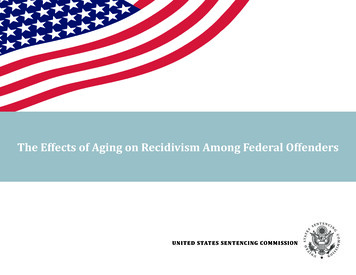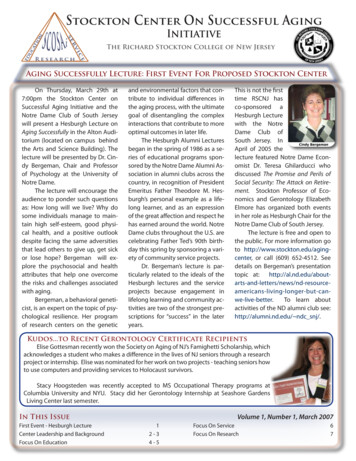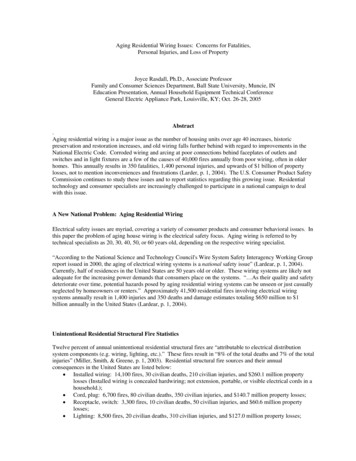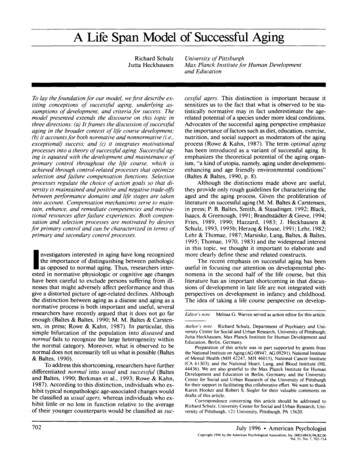
Transcription
The Effects of Aging on Recidivism Among Federal OffendersU N I T E D S TAT E S S E N T E NC I NG COM M I S S ION
United States Sentencing CommissionOne Columbus Circle, N.E.Washington, DC 20002www.ussc.govWilliam H. Pryor, Jr.Acting ChairRachel E. BarkowCommissionerCharles R. BreyerCommissionerDanny C. ReevesCommissionerZachary C. BolithoEx OfficioJ. Patricia Wilson SmootEx OfficioKenneth P. CohenStaff DirectorGlenn R. SchmittDirectorOffice of Research and DataDecember 2017
Kim Steven Hunt, Ph.D., Senior Research Associate, Office of Research and DataBilly Easley II, J.D., Legislative Affairs Specialist, Office of Legislative and Public Affairs
TABLE OF CONTENTSiPart OnePart TwoPart ThreePart FourEXECUTIVE SUMMARYDEFINING AND MEASURINGRECIDIVISMCHARACTERISTICS OFRECIDIVISM STUDY GROUP15INTRODUCTION TO AGE ANDRECIDIVISM AMONG FEDERALOFFENDERS9The Effects of Aging on Recidivism Among Federal Offenders13
Part FivePart SixPart SevenPart EightRECIDIVISM RATES AMONGFEDERAL OFFENDERS BY AGECONCLUSIONENDNOTESAPPENDIX21293337The Effects of Aging on Recidivism Among Federal Offendersii
Part OneExecutive Summary
Part One:EXECUTIVE SUMMARYIntroductionThe United States Sentencing Commission1 began studying recidivismshortly after the enactment of the Sentencing Reform Act of 1984 (“SRA”),and has issued several recent publications examining recidivism ratesamong federal offenders released in 2005. The Commission’s first report inthis series, Recidivism Among Federal Offenders: A Comprehensive Overview(“Recidivism Overview Report”), was released in March 2016 and discussedthis research project in greater detail. As noted in the previous reports in thisseries,2 recidivism information is central to three of the primary purposes ofpunishment described in the SRA—specific deterrence, incapacitation, andrehabilitation—all of which focus on prevention of future crimes throughcorrectional intervention. Information about recidivism is also relevant to theCommission’s obligation to formulate sentencing policy that “reflect[s], to theextent practicable, advancements in knowledge of human behavior as it relatesto the sentencing process.”3 Considerations of recidivism by federal offenderswere also central to the Commission’s initial work in developing the GuidelinesManual’s criminal history provisions4 as well as its ongoing work.52The Effects of Aging on Recidivism Among Federal OffendersThe Commission’s current recidivism research substantially expands on thescope of previous Commission recidivism projects. In addition to a different setof offenders—U.S. citizen federal offenders released in 2005—the current studygroup (25,431 offenders) is much larger than those in previous Commissionstudies. A larger study group allows for data analysis across many differentsubgroups of federal offenders, including those sentenced under differentprovisions in the guidelines.This report is the fourth in this series and focuses on the relationshipbetween age at release and recidivism. This report examines the impact of theaging process on federal offender recidivism and, once age is accounted for, theimpact of other offense and offender characteristics.
Key FindingsThe key findings of the Commission’s study of federal offenders’ recidivismby age at release are that: Older offenders were substantially less likely than youngeroffenders to recidivate following release. Over an eight-year follow-upperiod, 13.4 percent of offenders age 65 or older at the time of releasewere rearrested compared to 67.6 percent of offenders younger thanage 21 at the time of release. The pattern was consistent across agegroupings, and recidivism measured by rearrest, reconviction, andreincarceration declined as age increased. For federal offenders under age 30 at the time of release, overone-fourth (26.6%) who recidivated had assault as their most commonnew charge. By comparison, for offenders 60 years old or older at thetime of release, almost one quarter (23.7%) who recidivated had apublic order offense6 as their most serious new charge. Age and criminal history exerted a strong influence onrecidivism. For offenders in Criminal History Category I, the rearrestrate ranged from 53.0 percent for offenders younger than age 30 atthe time of release to 11.3 percent for offenders age 60 or older. Foroffenders in Criminal History Category VI, the rearrest rate rangedfrom 89.7 percent for offenders younger than age 30 at the time ofrelease to 37.7 percent for offenders age 60 or older. Education level influenced recidivism across almost allcategories. For example, among offenders under age 30 at the timeof release, college graduates had a substantially lower rearrest rate(27.0%) than offenders who did not complete high school (74.4%).Similarly, among offenders age 60 or older at the time of release,college graduates had a somewhat lower rearrest rate (11.6%) thanoffenders who did not complete high school (17.2%). Age exerted a strong influence on recidivism across allsentence length categories. Older offenders were less likely torecidivate after release than younger offenders who had served similarsentences, regardless of the length of sentence imposed. In addition,for younger offenders there was some association between the lengthof the original federal sentence and the rearrest rates, as youngeroffenders with sentences of up to six months generally had lowerrearrest rates than younger offenders with longer sentences. However,among all offenders sentenced to one year or more of imprisonment,there was no clear association between the length of sentence and therearrest rate. For certain major offense types, the type of federal offense thatoffenders had committed also had an effect on recidivism across agegroups. For example, firearms offenders had a substantially higherrearrest rate across all age categories than drug trafficking offenders,who in turn had a higher rearrest rate across all age categories thanfraud offenders. For example, for offenders under age 30 at the time ofrelease, the rearrest rates were 79.3 percent (firearms), 62.5 percent(drug trafficking), and 53.6 percent (fraud). Similarly, for offendersage 60 and older at the time of release, the rearrest rates were 30.2percent (firearms), 17.5 percent (drug trafficking), and 12.5 percent(fraud). At every age group, federal prisoners had a substantiallylower recidivism rate than state prisoners who also were releasedin 2005 and tracked by the Bureau of Justice Statistics. For example,for offenders age 24 or younger at the time of release, 63.2 percentof federal prisoners were rearrested within five years compared toover four-fifths (84.1%) of state prisoners. Like federal prisoners,older state prisoners were less likely to recidivate than younger stateprisoners.The Effects of Aging on Recidivism Among Federal Offenders3
Part TwoDefining and Measuring Recidivism
Part Two:DEFINING AND MEASURING RECIDIVISMDefining and Measuring RecidivismRecidivism “refers to a person’s relapse into criminal behavior, often afterthe person receives sanctions or undergoes intervention for a previous crime.”7Measuring recidivism informs decision making about issues such as pretrialdetention, appropriate sentence type and length, prisoner classification, prisonprogramming, and offender supervision in the community. It also allowspolicymakers to evaluate the performance of the criminal justice system asa whole.8 Recidivism is typically measured by criminal acts that resultedin the rearrest, reconviction, and/or reincarceration of the offender over aspecified period of time. These are the three recidivism measures used in thisreport, but the report primarily relies on the first—rearrest—with additionaldata regarding reconviction and reincarceration reported in the Appendix.Providing data about multiple measures of recidivism allows users to select theperformance measure best suited to their outcome of interest.Reincarceration classifies a person as a recidivist if a conviction or revocationresulted in a prison or jail sentence as punishment. The reincarceration measurecounts offenders who were reported as being incarcerated by the FederalBureau of Prisons, state prison, or local jail for any term of incarceration basedon their recidivism events. Incomplete criminal records also create missinginformation about reincarceration.11Reconviction classifies a person as a recidivist if an arrest resulted in asubsequent judicial conviction.9 Violations and revocations of supervision arenot included in reconvictions since no formal prosecution occurred. While stateshave improved the completeness of their criminal history records, a recentfederal study found significant gaps in reporting of dispositions following anarrest.10 Such gaps occurred in the criminal records used in this report, and leadto an undercounting of reconvictions, because missing dispositions for rearrestsare treated as if reconviction and reincarceration did not occur.In undertaking its current recidivism research, the Commission selected afollow-up period of eight years. It considered all recidivism events (includingfelonies, misdemeanors, and “technical” violations of the conditions ofsupervision), except minor traffic offenses, which occurred over that eight-yearperiod. While this report includes summary findings using all three measures(rearrest, reconviction, and reincarceration), it primarily relies on rearrestdata in providing more detailed information about the recidivism of federaloffenders.Rearrest classifies a person as a recidivist if he or she has been arrested fora new crime after being released into the community directly on probation orafter serving a term of imprisonment. Rearrest also includes arrests for allegedviolations of conditions of federal probation, federal supervised release, or stateparole. The number of rearrests in the Commission’s analysis is based on thenumber of unique arrest dates, regardless of the number of individual chargesarising from a single arrest event. Thus, if an offender was arrested on a singleoccasion for both driving under the influence and possession of cocaine, thatarrest date would constitute a single rearrest event.6The Effects of Aging on Recidivism Among Federal OffendersMany rearrests do not ultimately result in a reconviction or reincarcerationfor reasons relating to procedural safeguards (e.g., the suppression of evidencefor an unconstitutional search or seizure), lack of sufficient evidence toconvict or revoke, and prosecutorial or judicial resource limitations. To theextent that the rearrest event is an accurate indicator of relapse into criminalbehavior, excluding non-conviction or non-incarceration events will resultin underestimation of recidivism. Even using the least restrictive measure,rearrest, does not count the full extent of offender recidivism, as many crimesgo unreported to police or, if reported, do not result in an arrest. For thesereasons, no measure is perfect, and reporting several measures provides a morecomplete and nuanced picture of recidivism. The three measures overlap insome areas—meaning all offenders who were reconvicted or reincarcerated alsowere necessarily rearrested. Some offenders who were reconvicted, however,were not reincarcerated. Generally speaking, however, the measure of rearrestis larger than the measure of reconviction, which in turn is larger than themeasure of reincarceration.
The Effects of Aging on Recidivism Among Federal Offenders7
Part ThreeIntroduction to Age andRecidivism Among Federal Offenders
Part Three:INTRODUCTION TO AGE AND RECIDIVISM AMONG FEDERAL OFFENDERSAge and Recidivism Among Federal OffendersThis report examines the impact of the aging process on recidivism byfederal offenders. First, recidivism rates are presented by age at release.Next, the time to the first recidivism event is shown by age at release forthose offenders who recidivated. Studying the timing of recidivism can helpin understanding the process of desistance across various age cohorts. Thenumber of recidivism events and most serious type of post-release offenseamong those who recidivated by age at release are also discussed. Contrastingthe number and nature of crimes committed across age groups may reveal moreinformation about the threat to public safety posed by various age groups aswell as the process of desisting from crime across the aging process.The report then investigates the association between recidivism and factorssuch as criminal history, demographic factors, offense characteristics, andsentence length. This information is reported by age group in order to betterdistinguish the impact of these factors while controlling for age at release.As first noted in the Recidivism Overview Report, numerous recidivismstudies document well that older offenders are at lower risk for reoffending,12and the Commission’s own research has confirmed this finding for federaloffender populations.13 The Commission’s study found that among all federaloffenders released into the community in 2005, those who were below age 21at release had the highest rearrest rate at over two-thirds (67.6%). Conversely,those oldest at age of release, over 60 years old, had the lowest recidivism rate(16.0 %). For each age grouping shown in the previous report, the older the agegroup, the lower the rearrest rate. The same pattern held for reconviction andreincarceration rates.10The Effects of Aging on Recidivism Among Federal OffendersAccording to the National Institute of Justice, “the prevalence of offendingtends to increase from late childhood, peak in the teenage years (from 15 to19) and then decline in the early 20s.”14 Scholars have used official arrest datacollected by the Federal Bureau of Investigation (FBI) to construct an age-crimecurve15 which demonstrates graphically the relationship between age andarrests. National arrest data collected by the FBI in the Uniform Crime Report(UCR) since 193016 and compiled in the FBI’s Crimes in the United States reportsince 199517 has consistently supported this conclusion concerning age andcrime.Figure 1 shows a comparison of arrests by five-year age intervals beginningat age 20 for all 2016 U.S. arrests reported to the FBI and all adult arrestsreported in criminal history records provided by the FBI for federal offendersreleased in 2005, by identical age groupings.18 To construct the federal offenderdata, the Commission aggregated all arrest incidents from the federal offenders’entire criminal history as reported on state and federal records.19 That is, eacharrest charge is collected and grouped by the age of the offender at the time ofthat arrest, in the same manner as set forth in Table 20 of the 2016 Crimes in theUnited States report.
Figure 1 demonstrates the close tie between older age and declining arrests,in both the FBI’s UCR20 and prior arrest data obtained on federal offenders fromthe FBI’s Interstate Identification Index (III) system, which is a national indexof criminal histories. In general, the Commission found that total adult arrestsfor federal offenders were highest in the 20-24 age group, and declined sharplythereafter. The national FBI adult arrests in 2016 display the same pattern.Since arrests are closely associated with age, it is not surprising that federaloffenders who enter and exit the federal system at younger ages are moreprone to recidivate. In the following sections, this report examines the ageand recidivism connection in greater detail. Then this report analyzes age incombination with other offense and offender characteristics. This combinationin effect statistically controls for age and reveals the influence, or absence ofinfluence, of other factors which may be thought to impact recidivism over andabove the influence of aging.For both federal offenders’ prior arrest history and national 2016 arrests asreported by the FBI, older age groups had fewer arrests. While there are vastdifferences among individuals which are not explained by age, age is generallya strong factor influencing the likelihood of committing crime, although thereasons for this are complex.21Fig. 1 Total Arrests by AgeAll 2016 U.S. Arrests Compared to Recidivism Study Offenders’ Arrest Records2016 Crime in the United States (FBI) Arrests by 000400,000200,000020 to 2425 to 2930 to 3435 to 39Lifetime Arrests by Federal Offenders Released in 200580,00040 to 4445 to 4950 to 5455 to 5960 to 6465 and over70,00060,00050,00040,00030,00020,00010,000020 to 2425 to 2930 to 3435 to 3940 to 4445 to 4950 to 5455 to 5960 to 6465 and overSOURCE: U.S. Sentencing Commission’s 2005 Recidivism Release Cohort Datafile, RECID05 OFFUPDT and U.S. Department of Justice, Federal Bureau of Investigation Uniform CrimeReport, Crime in the United States (2015). The Commission excluded cases from this analysis that were missing information necessary to perform the analysis.The Effects of Aging on Recidivism Among Federal Offenders11
Part FourCharacteristics ofRecidivism Study Group
Part Four:CHARACTERISTICS OF RECIDIVISM STUDY GROUPCharacteristics of Recidivism Study GroupFig. 2 Age at Release for Recidivism Study OffendersThis report examines 25,431 offenders who were released into thecommunity (either from federal prison or on to probation) in calendar year2005 and, as discussed in the Recidivism Overview Report, were federaloffenders: who are citizens; whose pre-sentence investigation report was submitted to theCommission; whose federal sentence was not vacated.Offender DemographicsThe largest age cohort in this study was those offenders aged 30 to 34(18.3% of the total) at the time they were released from federal custody intothe community (Figure 2). The next largest cohorts at time of release wereoffenders aged 25 to 29 (16.4%) and 35 to 39 (15.3%).Among the racial and ethnic groups analyzed, most White offenders were40 years or older (51.6%) at the time of their release (Figure 3). This is theonly racial group in the study with more than half of offenders over the age of40. Black and Hispanic offenders were concentrated in the younger than 40 agecohorts, with Hispanic offenders the youngest of all racial groups (70.9% wereyounger than 40 at the time of release). The Other race category, which includesAmerican Indians, Alaskan Natives and Asians were also mostly below age 40(62.9%).The Effects of Aging on Recidivism Among Federal OffendersYounger than 21 Years1.6%(n 398)21 to 24 Years8.8%(n 2,234)25 to 29 Years16.4%(n 4,164)45 to 49 Years10.1%(n 2,569)40 to 44 Years13.1%(n 3,325)who have valid FBI numbers which could be located in criminalhistory repositories (in at least one of the 50 states, DC, orfederal records);who were not reported dead, escaped, or detained; and65 Years orOlder2.1%(n 536)50 to 54 Years6.8%(n 1,734)who re-entered the community after discharging theirsentences of incarceration or by commencing a term ofprobation in 2005;The advantages of this large study group are substantial. Having severalthousand offenders allows more precise estimates of recidivism rates acrossdifferent subgroups. For example, there are 1,048 released offenders who wereolder than 60 years of age.1455 to 59 Years4.9%(n 1,235)60 to 64 Years2.6%(n 668)30 to 34 Years18.3%(n 4,635)35 to 39 Years15.3%(n 3,888)SOURCE: U.S. Sentencing Commission’s 2005 Recidivism Release Cohort Datafile, RECID05 OFFUPDT. TheCommission excluded cases from this analysis that were missing information necessary to perform theanalysis. Totals may not sum to 100.0% due to rounding.Fig. 3 Race of Recidivism Study Offenders by Age at Release60 Yearsor Older7.6%Whiten 11,07450 to 59Years16.2%40 to 49Years27.8%50 to 59Years7.5%60 Years or HispanicOldern 4,5082.8%40 to 49Years18.7%30 to 39Years32.9%Youngerthan 30Years20.5%50 to 59Years8.4%60 Years or BlackOldern 8,6072.2%40 to 49Years19.6%30 to 39Years27.9%Younger than30 Years38.0%50 to 59Years9.3%40 to 49Years23.9%60 Years or Othern 1,174Older3.9%Younger than30 Years28.0%30 to 39Years41.9%Younger than30 Years34.2%30 to 39Years28.7%SOURCE: U.S. Sentencing Commission’s 2005 Recidivism Release Cohort Datafile, RECID05 OFFUPDT. The Commission excluded cases from this analysis that weremissing information necessary to perform the analysis. Totals may not sum to 100.0% due to rounding.
The average age of offenders at the time of release increased as educationallevel increased (Figure 4). Offenders who did not complete high school werethe youngest group at the age of release, with 68.5 percent below the age of 40.College graduates were significantly older on average than offenders in othereducational cohorts, with around 71.0 percent of college graduates age 40 orolder.Female offenders were slightly younger on average than male offendersat the time of release (Figure 5). Specifically, a greater proportion of femaleoffenders were younger than 30 at the time of release, 31.2 percent, comparedto 25.8 percent of male offenders.Fig. 4 Education of Recidivism Study Offenders by Age at ReleaseFig. 5 Gender of Recidivism Study Offenders by Age at ReleaseLess Than High Schooln 8,64160 Years orOlder50 to 59 4.0%Years8.1%Youngerthan 30Years35.5%40 to 49Years19.4%30 to 39Years33.0%60 Years orOlder4.6%50 to 59Years13.8%40 to 49Years24.3%Some Collegen 5,399Younger than30 Years21.7%30 to 39Years35.6%60 Years orOlder3.8%50 to 59Years10.2%High School Graduaten 9,309Younger than30 Years25.9%40 to 49Years24.9%60 Years orOlder12.8%50 to 59Years29.3%30 to 39Years35.1%College Graduaten 1,879Youngerthan 30Years5.9%30 to 39Years23.0%60 Years orOlder5.1%50 to 59 Years11.8%40 to 49Years23.1%Malen 20,723Younger than30 Years25.8%30 to 39 Years34.2%60 Years orOlder3.2%Femalen 4,65450 to 59 Years11.1%Younger than30 Years31.2%40 to 49Years23.9%30 to 39 Years30.7%SOURCE: U.S. Sentencing Commission’s 2005 Recidivism Release Cohort Datafile, RECID05 OFFUPDT. The Commission excluded cases from this analysis that were missinginformation necessary to perform the analysis. Totals may not sum to 100.0% due to rounding.40 to 49Years28.9%SOURCE: U.S. Sentencing Commission’s 2005 Recidivism Release Cohort Datafile, RECID05 OFFUPDT. The Commission excluded cases from this analysis that were missinginformation necessary to perform the analysis. Totals may not sum to 100.0% due to rounding.The Effects of Aging on Recidivism Among Federal Offenders15
Part Four:CHARACTERISTICS OF RECIDIVISM STUDY GROUPFederal Offense Type and Criminal HistoryDrug trafficking offenders were generally the youngest group of offendersat the time of release (Figure 6). Of all drug trafficking offenders, 68.0 percentwere below the age of 40. By comparison, 66.5 percent of firearms offendersand 60.3 percent of robbery offenders were below the age of 40. Fraudoffenders were the oldest group with 55.0 percent age 40 or older at the time ofrelease.Fig. 6 Primary Offense Type of Recidivism Study Offenders by Age at Release60 Years orOlder3.0%50 to 59Years8.3%Drug Trafficking60 Yearsn 10,577or Older50 to 59 2.7%Years9.0%60 Yearsor Older2.6%40 to 49Years20.3%60 Years orOlder8.6%50 to 59Years18.0%40 to 49Years28.4%Younger than30 Years29.4%30 to 39 Years38.6%Fraudn 3,440Younger than30 Years14.9%30 to 39Years30.2%50 to 59Years9.8%40 to 49Years27.1%Robberyn 1,09830 to 39Years34.2%Younger than30 Years33.3%30 to 39 Years33.2%All Othern 7,03150 to 59Years14.5%Younger than30 Years25.8%40 to 49Years24.8%SOURCE: U.S. Sentencing Commission’s 2005 Recidivism Release Cohort Datafile, RECID05 OFFUPDT. The Commission excluded cases from this analysis that were missinginformation necessary to perform the analysis. Totals may not sum to 100.0% due to rounding.16Fig. 7 Weapon Enhancement of Recidivism Study Offenders by Age at ReleaseFirearmsn 3,23840 to 49Years22.3%Youngerthan 30Years26.1%60 Years orOlder7.1%Over two-thirds (67.0%) of offenders subject to weapons enhancementswere younger than age 40 at the time of release compared to 59.6 percent ofoffenders who were not subject to such enhancements (Figure 7).The Effects of Aging on Recidivism Among Federal Offenders30 to 39Years27.9%60 Years orOlder2.6%50 to 59 Years8.9%Weapon Enhancementn 2,498Younger than30 Years26.4%40 to 49Years21.5%60 Years orOlder5.0%50 to 59 Years12.0%No Weapon Enhancementn 22,888Younger than30 Years26.8%40 to 49Years23.4%30 to 39 Years40.6%30 to 39 Years32.8%SOURCE: U.S. Sentencing Commission’s 2005 Recidivism Release Cohort Datafile, RECID05 OFFUPDT. The Commission excluded cases from this analysis that were missinginformation necessary to perform the analysis. Totals may not sum to 100.0% due to rounding.
Overall, the age of offenders increased as the offenders’ prior criminalhistory increased (Figure 8). A federal offender’s prior criminal history scoreis calculated under Chapter Four of the Guidelines Manual and assigned one ofsix Criminal History Categories (CHC), CHC I through VI, with CHC VI being thehighest prior record category.22 Category I had a larger proportion of offendersyounger than 30 years (27.8%) than Category VI (11.1%).23 Conversely,Category VI had the largest group of offenders age 40 or older (47.1%).Fig. 8 Criminal History Category of Recidivism Study Offenders by Age at Release60 Yearsor Older6.5%Category In 13,54950 to 59Years13.9%30 to 39Years28.7%40 to 49Years23.1%50 to 59Years7.7%60 Yearsor Older2.1%40 to 49Years20.0%Youngerthan 30Years27.8%Category IVn 1,995Youngerthan 30Years28.5%30 to 39Years41.9%60 Years or Older Category IIn 3,0823.4%50 to 59Years10.3%40 to 49Years21.9%60 Years Category Vor Oldern 1,11950 to 59 1.6%Years8.2%40 to 49Years25.2%Younger than30 Years29.0%30 to 39Years35.4%Youngerthan 30Years21.8%30 to 39Years43.2%60 Yearsor Older2.9%50 to 59Years8.1%Fig. 9 Base Offense Level of Recidivism Study Offenders by Age at ReleaseCategory IIIn 3,61040 to 49Years20.7%50 to 59Years11.7%The offender’s base offense level is determined by applying the Chapter Twoguideline level associated with the conviction offense (Figure 9). A high baseoffense level, defined as a base offense level of 32 or higher, was associated witha high percentage of offenders between the ages of 30 to 39. Offenders betweenthe ages of 30 to 39 were the only age group to increase consistently acrossall three categories as shown in Figure 9, from 29.8 percent to 45.4 percent.Offenders younger than 30 reached a high of 31.2 percent in the base offenselevel 26 to 31 category but decreased to 18.1 percent among the most seriouscategory of offenders with a base offense level between 32 and 43.60 Years Category VIn 1,921or Older2.8%40 to 49Years32.6%SOURCE: U.S. Sentencing Commission’s 2005 Recidivism Release Cohort Datafile, RECID05 OFFUPDT. The Commission excluded cases from this analysis that were missinginformation necessary to perform the analysis. Totals may not sum to 100.0% due to rounding.Youngerthan 30Years30.3%30 to 39Years38.0%Younger than30 Years11.1%50 to 59Years12.9%60 Years orOlder2.7%50 to 59Years8.5%40 to 49Years20.2%30 to 39Years41.8%BOL 26 to 31n 4,46360 Years orOlder5.6%40 to 49Years24.1%Youngerthan 30Years31.2%30 to 39Years37.5%BOL 6 to 25n 16,937Younger than30 Years27.6%30 to 39Years29.8%60 Years orOlder3.5%BOL 32 to 43n 3,96750 to 59Years10.0%40 to 49Years23.0%Younger than30 Years18.1%30 to 39Years45.4%SOURCE: U.S. Sentencing Commission’s 2005 Recidivism Release Cohort Datafile, RECID05 OFFUPDT. The Commission excluded cases from this analysis that were missinginformation necessary to perform the analysis. Totals may not sum to 100.0% due to rounding.The Effects of Aging on Recidivism Among Federal Offenders17
Part Four:CHARACTERISTICS OF RECIDIVISM STUDY GROUPSentences ImposedFor statistical purposes, the Commission groups the type of federal sentenceoriginally imposed into four categories: prison only, prison and communityconfinement, probation and confinement, and probation or fine only.24 Prisononly offenders were the youngest group at release in the Commission’s study,with 61.9 percent of the offenders who received a prison only sentence underthe age of 40 (Figure 10). Offenders who served prison and communityconfinement sentences were the oldest, with 48.1 percent age 40 or older.Fig. 10 Sentence Type of Recidivism Study Offenders by Age at Release60 Years orOlder4.1%50 to 59Years11.0%40 to 49Years23.0%Prison Onlyn 19,572Younger than30 Years26.3%30 to 39Years35.6%Probation and Confinementn 1,19160 Years orOlder7.3%50 to 59Years15.0%40 to 49Years23.7%Younger than30 Years28.6%30 to 39Years25.4%Prison/Community Split Sentencen 973Younger than60 Years orOlder6.2%30 Years26.8%50 to 59Years14.4%30 to 39Years25.1%40 to 49Years27.5%60 Years orOlder6.8%Probation or Fine Onlyn 3,613Youngerthan 30Years28.8%50 to 59Years14.0%40 to 49Years23.1%30 to 39Years27.4%SOURCE: U.S. Sentencing Commission’s 2005 Recidivism Release Cohort Datafile, RECID05 OFFUPDT. The Commission excluded cases from this analysis thatwere missing information necessary to perform the analysis. Totals may not sum to 100.0% due to rounding.18The Effects of Aging on Recidivism Among Federal OffendersThe Commission also considered the length of the federal sentence imposedon those in the study group. Offenders serving the longest sentences were theoldest at time of release (Figure 11). For offenders who served a sentence of120 months or more, the proportion of offenders who were age 40 or older atthe time they were released was 48.6 percent, higher than any other group.In contrast, among offenders who served a sentence of 60 to 119 months, theproportion age 40 or older was 36.3 percent, the same proportion as offenderswho served a sentence of 24 to 59 months.Fig. 11 Length of Federal Sentence of Recidivism Study Offenders by Age at Release60 Yearsor Older5.3%Up to 6 Monthsn 1,04750 to 59Years14.0%40 to 49Years26.1%60 Years orOlder4.0%50 to 59Years10.6%40 to 49Years21.7%Younger than30 Years28.1%30 to 39Ye
Dec 07, 2017 · rate ranged from 53.0 percent for offenders younger than age 30 at the time of release to 11.3 percent for offenders age 60 or older. For offenders in Criminal History Category VI, the rearrest rate ranged from 89.7 percent for offenders younger than age 30 at the time of release to 37.











